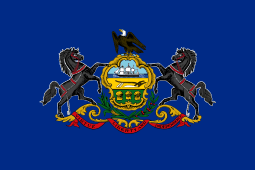Hope Lodge (Whitemarsh Township, Pennsylvania)
|
Hope Lodge | |
|
Hope Lodge, circa 1937. | |
  | |
| Location | Fort Washington, Pennsylvania |
|---|---|
| Built | 1750 |
| Architect | Edmund Woolley |
| Architectural style | Georgian |
| NRHP Reference # | 72001141[1] |
| Significant dates | |
| Added to NRHP | April 26, 1972 |
| Designated PHMC | February 16, 1966[2] |
Hope Lodge is a historic building located at 553 South Bethlehem Pike in Fort Washington, Pennsylvania, in the United States. It was used by Continental troops during the 1777 Philadelphia Campaign during the American Revolution.[3]
History
Originally named "Whitemarsh Estate," Hope Lodge is a Georgian country mansion built between 1743 and 1748 by Quaker businessman Samuel Morris and designed by Philadelphia architect Edmund Woolley. Upon Morris's death in 1770, his brother Joshua sold the property to William West, another Philadelphia merchant. During the autumn of 1777, Washington's Continental Army spent six weeks camped at nearby Whitemarsh. During the encampment, Hope Lodge was used as a hospital by George Washington's surgeon general John Cochran, and as quarters for Major General Nathanael Greene. When West died in 1784, the house was purchased by the English banker Henry Hope (to whom Adam Smith dedicated The Wealth of Nations and whose family would later own and lend their name to the Hope Diamond) and it was presented as a wedding gift to his ward, James Watmough. In 1832, the Watmough family sold the property to Jacob Wentz, their tenant farmer, and the Wentz family remained in residence at Hope Lodge for ninety years. In 1921, the property was sold to Keasbey and Mattison Company, who intended to demolish the home to expand a nearby limestone quarry. Hope Lodge was saved from destruction by William and Alice Degn, who purchased the property from Keasbey and Mattison in 1922. In 1957, ownership of the lodge was transferred to the Commonwealth of Pennsylvania.
Hope Lodge is listed on the U.S. National Register of Historic Places.
Mather Mill is part of the Hope Lodge property, but is not open due to structural reasons.[4]
Hope Lodge Today
Hope Lodge was operated by the Pennsylvania Historical and Museum Commission as a museum and historic site. On November 20, 2009, the site was closed due to state budget constraints which reduced the agency's budget by 43%. This reduction resulted in mass layoff of PHMC employees, and the closure or reduction in hours and/or services at many PHMC-operated sites throughout the state of Pennsylvania.
Despite the closure, the grounds play host to various community events, such as Ambler Symphony concerts; as well as an annual reenactment of the 1777 Whitemarsh Encampment.
Owners of Hope Lodge
- 1743 to 1770: Samuel Morris (1709-1770)[5]
- 1770 to 1776: Joshua Morris
- 1776 to 1784: William and Mary West[6]
- 1784 to 1832: Watmough Family[6]
- 1832 to 1921: Wentz Family[6]
- 1921 to 1922: Keasbey and Mattison Company[6]
- 1922 to 1957: William and Alice Degn[6]
- 1957 to Present: Pennsylvania Historical and Museum Commission
See also
Further reading
- H.D. Eberlein and H.M. Lippincott, The Colonial Homes of Philadelphia and Its Neighbourhood, J.B. Lippincott Co., Phila. and London, 1912.
References
- ↑ National Park Service (2007-01-23). "National Register Information System". National Register of Historic Places. National Park Service.
- ↑ "PHMC Historical Markers". Historical Marker Database. Pennsylvania Historical & Museum Commission. Retrieved December 30, 2013.
- ↑ "Hope Lodge" (PDF). National Register of Historic Places Nomination Form. Pennsylvania Historical and Museum Commission. 1971. Retrieved December 30, 2013.
- ↑ "Mather Mill (Farmar's Mill)". Hope Lodge. Retrieved 1 October 2014.
- ↑ "Hope Lodge". Pennsylvania Historical and Museum Commission. Retrieved 5 August 2015.
- 1 2 3 4 5 Treese, Lorett (2001). Hope Lodge and Mather Mill (1st ed.). Mechanicsburg, Pa.: Stackpole Books. ISBN 9780811724715. Retrieved 5 August 2015.
External links
- Historic Hope Lodge - Witness to America
- Hope Lodge at the Historic American Buildings Survey (HABS) (Library of Congress)
- Pennsylvania Historical and Museum Commission
- "Through a Looking Glass: Colonial and Colonial Revival Hope Lodge" article from Pennsylvania Heritage Magazine
Coordinates: 40°07′30″N 75°13′00″W / 40.124996°N 75.216758°W
.jpg)


